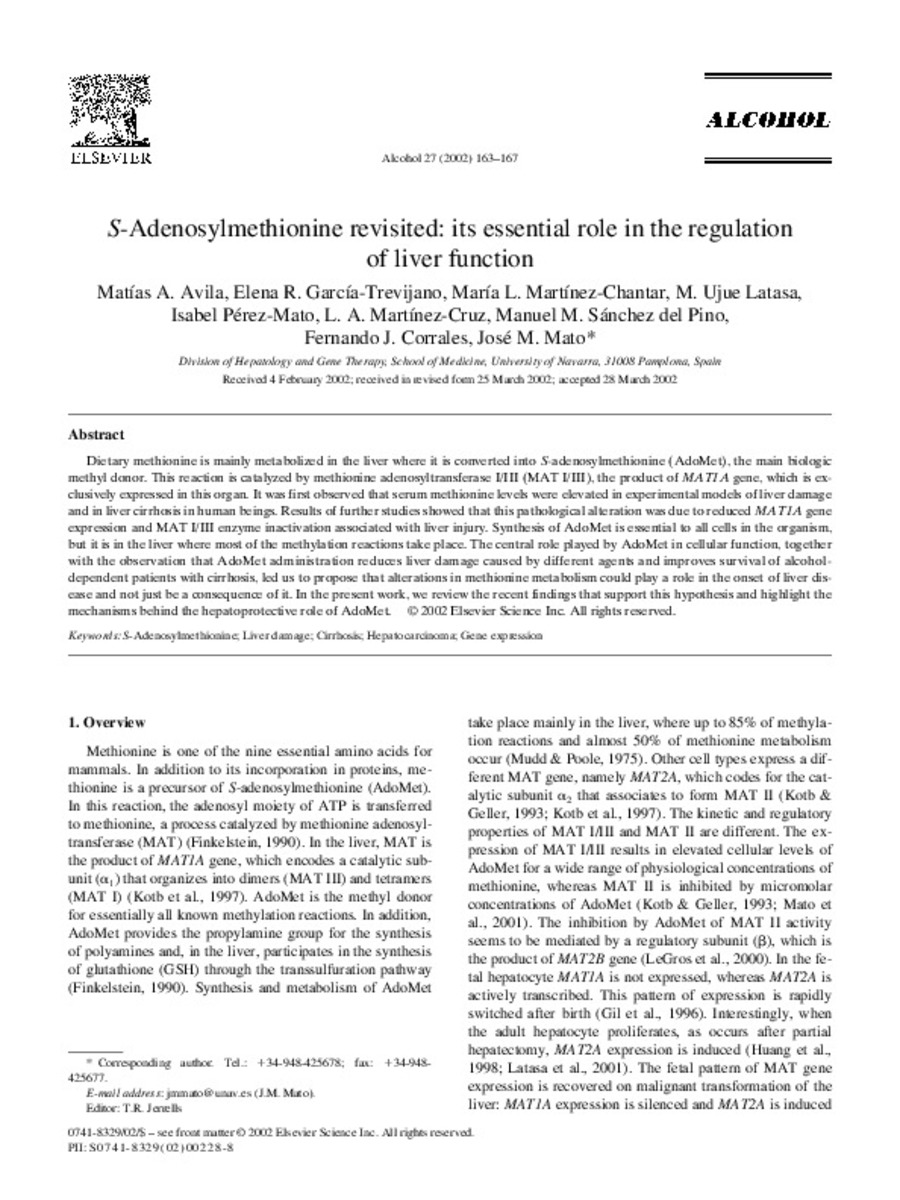Full metadata record
| DC Field | Value | Language |
|---|---|---|
| dc.creator | Avila, M.A. (Matías Antonio) | - |
| dc.creator | Ruiz Garcia-Trevijano, E. (Elena) | - |
| dc.creator | Martinez-Chantar, M.L. (María Luz) | - |
| dc.creator | Latasa, M.U. (María Ujué) | - |
| dc.creator | Perez-Mato, I. (Isabel) | - |
| dc.creator | Martinez-Cruz, L.A. (L. Alfonso) | - |
| dc.creator | Sanchez-del-Pino, M.M. (Manuel M.) | - |
| dc.creator | Corrales, F.J. (Fernando José) | - |
| dc.creator | Mato, J.M. (José María) | - |
| dc.date.accessioned | 2012-03-28T08:43:35Z | - |
| dc.date.available | 2012-03-28T08:43:35Z | - |
| dc.date.issued | 2002 | - |
| dc.identifier.citation | Avila MA, Garcia-Trevijano ER, Martinez-Chantar ML, Latasa MU, Perez-Mato I, Martinez-Cruz LA, et al. S-Adenosylmethionine revisited: its essential role in the regulation of liver function. Alcohol 2002 Jul;27(3):163-167. | es_ES |
| dc.identifier.issn | 1873-6823 | - |
| dc.identifier.uri | https://hdl.handle.net/10171/21381 | - |
| dc.description.abstract | Dietary methionine is mainly metabolized in the liver where it is converted into S-adenosylmethionine (AdoMet), the main biologic methyl donor. This reaction is catalyzed by methionine adenosyltransferase I/III (MAT I/III), the product of MAT1A gene, which is exclusively expressed in this organ. It was first observed that serum methionine levels were elevated in experimental models of liver damage and in liver cirrhosis in human beings. Results of further studies showed that this pathological alteration was due to reduced MAT1A gene expression and MAT I/III enzyme inactivation associated with liver injury. Synthesis of AdoMet is essential to all cells in the organism, but it is in the liver where most of the methylation reactions take place. The central role played by AdoMet in cellular function, together with the observation that AdoMet administration reduces liver damage caused by different agents and improves survival of alcohol-dependent patients with cirrhosis, led us to propose that alterations in methionine metabolism could play a role in the onset of liver disease and not just be a consequence of it. In the present work, we review the recent findings that support this hypothesis and highlight the mechanisms behind the hepatoprotective role of AdoMet. | es_ES |
| dc.language.iso | eng | es_ES |
| dc.publisher | Elsevier Masson | es_ES |
| dc.rights | info:eu-repo/semantics/openAccess | es_ES |
| dc.subject | S -Adenosylmethionine | es_ES |
| dc.subject | Liver damage | es_ES |
| dc.subject | Cirrhosis | es_ES |
| dc.subject | Hepatocarcinoma | es_ES |
| dc.subject | Gene expression | es_ES |
| dc.title | S-Adenosylmethionine revisited: its essential role in the regulation of liver function | es_ES |
| dc.type | info:eu-repo/semantics/article | es_ES |
| dc.relation.publisherversion | http://www.sciencedirect.com/science/article/pii/S0741832902002288 | es_ES |
| dc.type.driver | info:eu-repo/semantics/article | es_ES |
Files in This Item:
Statistics and impact
Items in Dadun are protected by copyright, with all rights reserved, unless otherwise indicated.






